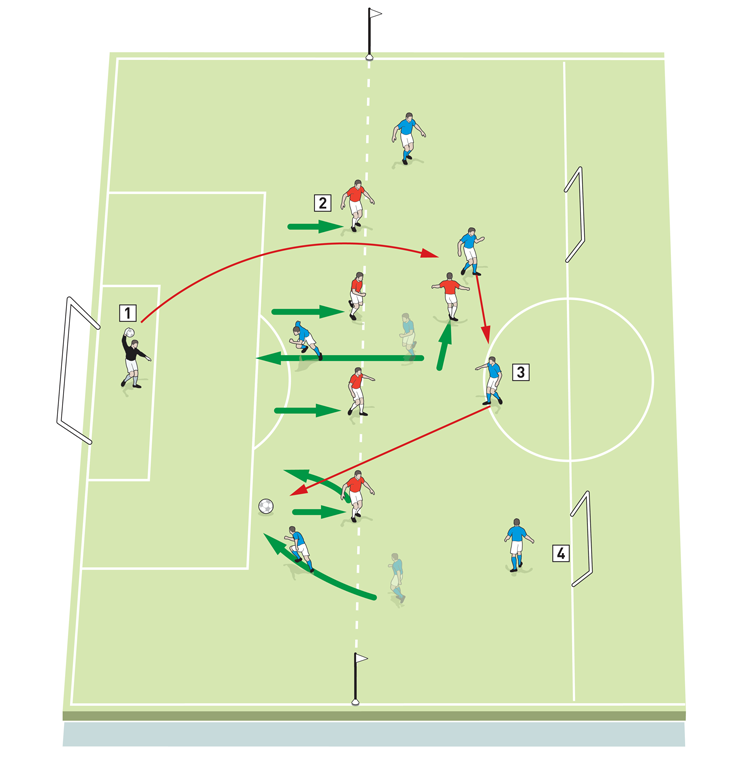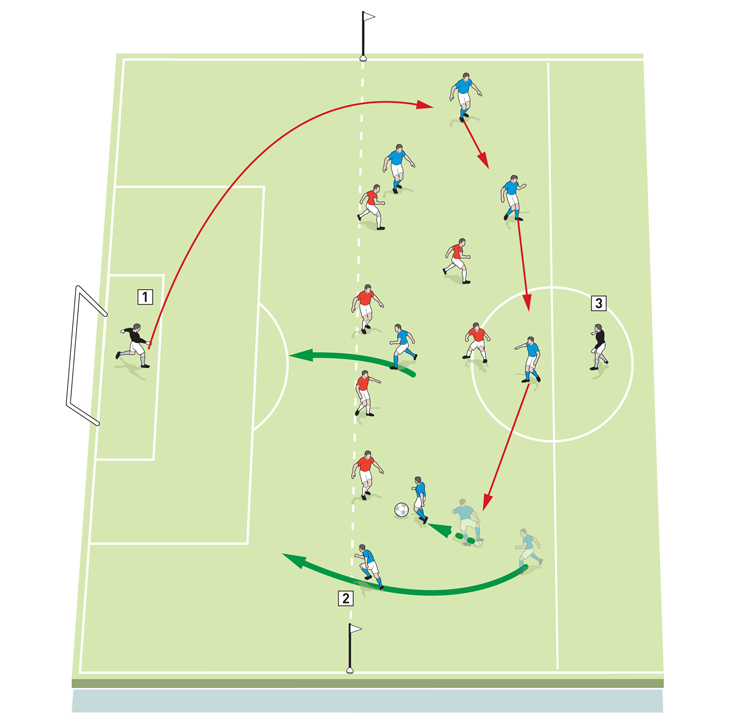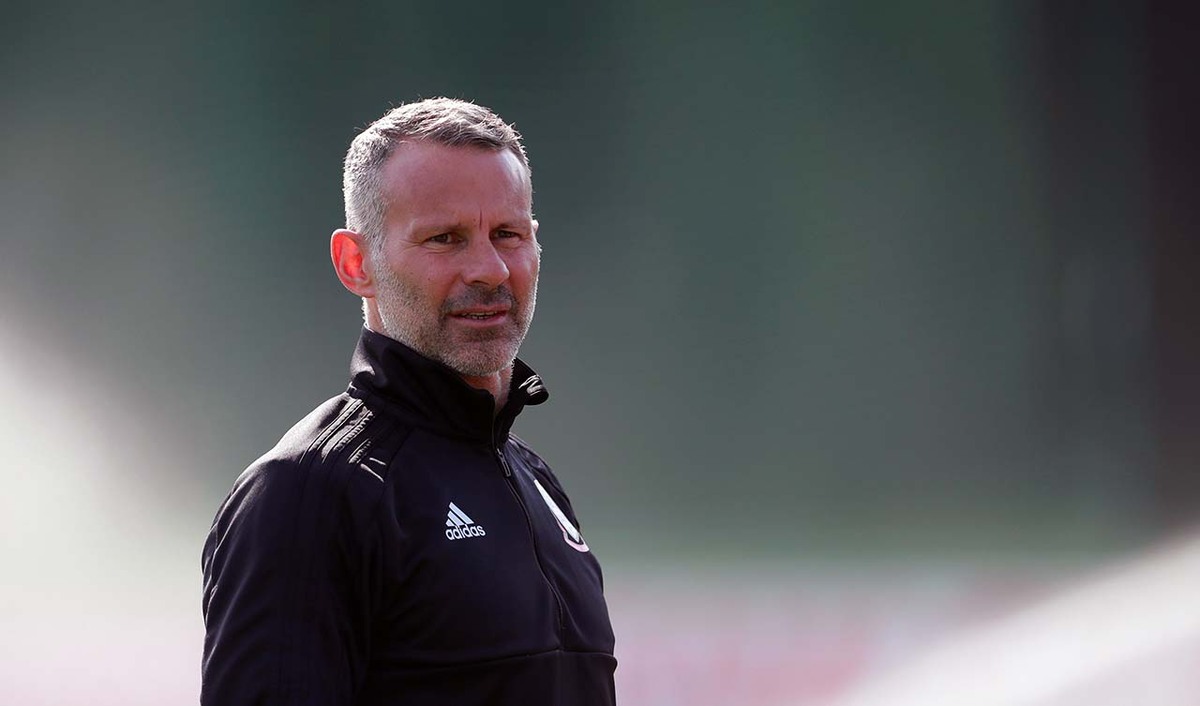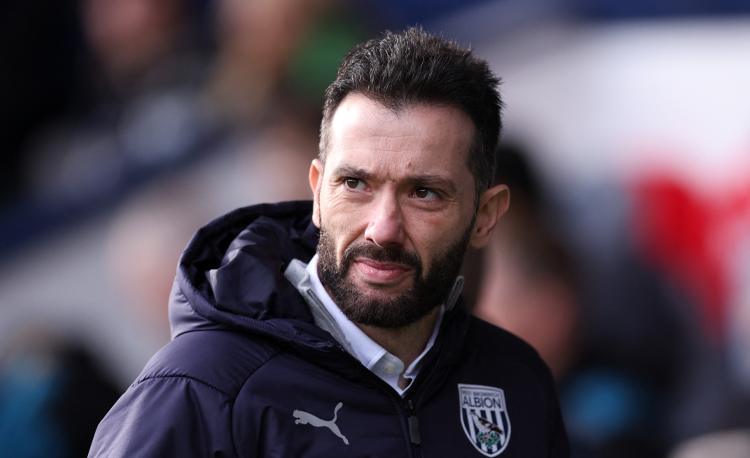You are viewing 1 of your 1 free articles
Attack against defence
In this session, because the defending team is facing an overload, it is important for them to work together in the best ways possible. It is up to the attacking team to take advantage of their overload and score goals.
| Area | Up to half a pitch |
| Equipment | Balls, bibs, cones, poles, 2 full size goals, 2 small goals |
| No. of Players | Up to 13 players + 2 goalkeepers |
| Session Time | Search a line: 18mins, 6v5 + keeper: 15mins, 7v6 + keeper: 15mins |
This session is all about attack against defence in various situations. Because the defending team is facing an overload, it is important for them to work together in the best ways possible. The real test for the attacking team is to take advantage of their overload and to show they can find the free player to create as many scoring chances possible.
Working with a national team is very different from working at a club, where there is more time to develop the players and the way of playing. Time is limited with the national team and we must accept we cannot do all the things we would like.
It would be a mistake to burden the players with too much information, so we must choose our priorities and be creative. We try to be as efficient as possible in how we set up our training sessions. That means most of the time we focus on more than one objective in the exercises we choose. We organise the session so that, for example, one coach will focus on the aims in defending and attacking transition and the other coach will focus more on the aims in attacking and defensive transition. In this way we try to use our limited training time in the best way possible.
We try to make all of our exercises as competitive as possible and to do everything at match speed and tempo, as it must be challenging for both teams. This will create an environment where players want to give everything to win games.
We would run these activities two or three days before a game, as they provide a very efficient way of making our playing principles clear.
What do I get the players to do?
Search a line
We set up an area of 33x22 yards with two full size goals and two 8-yard end zones. We begin with 4 attackers, 2 defenders and 1 goalkeeper on the pitch, lined up in starting positions down the centre of the pitch, as shown [1a]. Another attacker and 3 more defenders wait for their turns at the side. The goalkeeper is at the end that the attackers must try to score in. The other goal is unguarded and is for the defenders to score in.
1a

2. The red defenders press to overturn possession. If they win the ball they can attack the unguarded goal
3. The attackers combine to get the ball to their team mate at the other end of the pitch. They must then switch the direction of play and attack the goal with the keeper
Play starts with a serve from the waiting attacker to the free attacker at the end of the pitch with the goalkeeper. The four active attackers (the blues) must combine to get the ball to the other side of the pitch, while the defenders (the reds) must try to prevent this for as long as possible by keeping the middle closed and forcing the ball to the sides. If the defenders overturn possession, they can try to score in the unguarded goal. They can use the help of the goalkeeper if needed.
Once the ball has reached the attacker in the opposite half, the first attacker has to leave the pitch and his team attacks the end where the ball started – it’s a 3v2 against the defenders and the attackers must try to score past the keeper, as shown [1b]. Only the keeper is allowed in the end zone.
1b

2. The first attacker must leave the pitch once the direction of play switches, making it a 3v2 attack
3. The halfway line is the offside line
4. Only the goalkeeper is allowed inside the end zone
It’s important that the coaches keep score. It’s about attackers against defenders, so it’s all about winning!
The halfway line serves as the offside line. Play for 18 minutes. After 9 minutes, switch the side where the first pass comes from. When there has been a goal or if the ball goes out of play, the attackers rotate by moving one position down the line. Switch defenders after two attacks.
How do I progress the session?
There are a few options to keep the exercise challenging for both teams. To challenge the defenders, we can make the playing area wider, and instead of a full size goal, we could use two small goals.
To challenge the attackers, we could make the playing area smaller to make it more difficult, or we could limit the amount or touches taken. We could change it to allow one defender to sprint back and support his team mates, making the attack 3v3 instead of 3v2. We could also change the rules so goals for the defenders count double – this would make it even more important for the attackers to react quickly after losing the ball.
What are the key things to look out for?
We want to see the attackers doing the simple things well, with good passing, control and movement. Attackers should be brave in their decisions but precise in the execution. We also want to see the attackers giving passing options to team mates and they should never be in the same line – when a team mate in front moves left, the player should go right.
Attackers have various options that we want to see employed: they should look for the forward pass when possible or switch the play to create a 2v1 situation, or they should dribble to pass or overlap.
When the attackers lose the ball, we want to see quick reactions because there is no time for disappointment – they should immediately put pressure on the ball or the closest opponent. If they can’t win the ball back, they should stop the pass forward, force the ball wide or back and stay involved.
When the defenders win possession and transition to attack, we want to see them looking for a quick forward pass, but if the pass isn’t on, they should keep hold of the ball, using the keeper if necessary, and create the option to play forward.
What do I get the players to do next?
Attack v defence: 6v5 +keeper
Next we progress to a bigger space with more players involved. The basic principles stay the same but because of the increase in numbers it becomes more complex and much more game-related.
We set up on half of the pitch with a full size goal at one end and two small goals at the other. Poles on either side of the pitch mark the defensive line.
We are using 1 goalkeeper and 11 outfield players split into a defending team of 5 (the reds – lined up in a formation of 4 defenders and 1 midfielder) and an attacking team of 6 (the blues – with 3 midfielders and 3 forwards).
Play starts with a kick or a throw from the keeper toward the attackers. At the same time the defenders will push up towards the defensive line. Attackers must react to the advantage the overload situation gives them and try to exploit the space behind the defence, as shown [2].
2

2. As the keeper plays the first ball, the defenders (the reds) should push up to the defensive line
3. Here the attackers take advantage of their overload and try to exploit the space behind the defence
4. The defenders must try to block the attack. If they win the ball they must try to score in the small goals on the halfway line
The defenders must try to block the attacks and win the ball, creating chances to score in the unguarded small goals on the halfway line.
We usually play in blocks of four one-minute attacks. If the ball goes dead, as long as the time for an attack has not run out, we would play a second ball in to the attackers. We want to have as many attacks as possible and we like to keep the pressure on the defenders. We would play three blocks, so around 15 minutes, rotating players every minute.
What are the key things to look out for?
We want to see the defenders keeping it compact. When the ball moves, the defenders should move too, making the space small and keeping the attackers away from the goal for as long as possible.
If a central defender needs to step out to keep pressure on the ball, the other three defenders will make the space small behind him. If necessary, the holding midfielder can drop into the back line when a defender needs to step out or is outplayed.
The attackers should try to keep the ball speed high but also change the tempo, accelerating at the right moments. If the attackers have the ball on one side of the pitch, we want to see them switch the play as quickly as possible to get the wingers into 1v1 situations.
The wide players should look to cross early, firing the ball between the defenders and the goalkeeper and supporting attackers should be ready to make the runs to the front and back posts.
How do I progress the session?
Attack v defence: 7v6 +keeper
The principles remain the same, but we change the basic set-up by adding an outfield player and a goalkeeper to the attacking team. The formation is altered so they have 2 full backs and 2 midfielders instead of 3 midfielders. The defending team now has an additional player in midfield. We also remove the small goals on the halfway line, replacing them with the extra goalkeeper.
The exercise starts with a kick or a throw from the defending team’s goalkeeper toward the attackers. At the same time the defenders will push up towards the defensive line. The attackers must try to score in the goal and, as they are now playing with two full backs who overlap on the wings, they will create more 2v1s with the defenders, as shown [3]. If the defenders win the ball, they pass it to the keeper on the halfway line.
3

2. The attackers are now playing with 2 full backs, who overlap on the wings to create more 2v1s with the defenders
3. The defending team (the reds)must try to win the ball and pass to the goalkeeper on the halfway line
Related Files
Editor's Picks
Using the goalkeeper in build-up play
Pressing principles
Intensive boxes drill with goals
Penetrating the final third
Creating and finishing
My philosophy
Pressing initiation
Compact team movement
Defensive organisation
Coaches' Testimonials

Alan Pardew

Arsène Wenger

Brendan Rodgers

Carlos Carvalhal

José Mourinho

Jürgen Klopp

Pep Guardiola

Roy Hodgson

Sir Alex Ferguson

Steven Gerrard
Related
Coaches' Testimonials

Gerald Kearney, Downtown Las Vegas Soccer Club

Paul Butler, Florida, USA

Rick Shields, Springboro, USA

Tony Green, Pierrefonds Titans, Quebec, Canada
Join the world's leading coaches and managers and discover for yourself one of the best kept secrets in coaching. No other training tool on the planet is written or read by the calibre of names you’ll find in Elite Soccer.
In a recent survey 92% of subscribers said Elite Soccer makes them more confident, 89% said it makes them a more effective coach and 91% said it makes them more inspired.
Get Monthly Inspiration
All the latest techniques and approaches
Since 2010 Elite Soccer has given subscribers exclusive insight into the training ground practices of the world’s best coaches. Published in partnership with the League Managers Association we have unparalleled access to the leading lights in the English leagues, as well as a host of international managers.
Elite Soccer exclusively features sessions written by the coaches themselves. There are no observed sessions and no sessions “in the style of”, just first-hand advice delivered direct to you from the coach.









